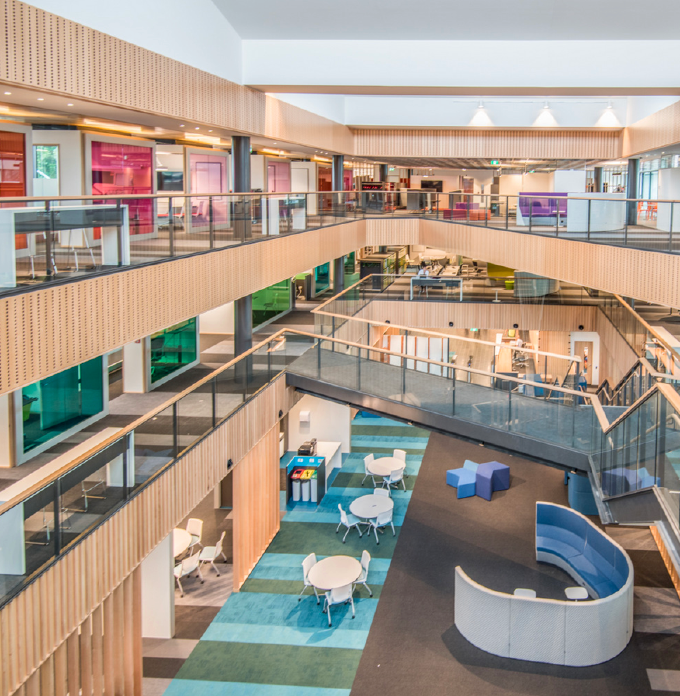October 24, 2025
Habitat
The best measure of success in workplace design is how people feel at work.

Note the absence of traditional enclosed offices in this rendering. With various collaborative areas spread across multiple floors, this space is designed to foster interaction and movement. Extensive use of glass and open sightlines encourages visibility and creates a sense of shared community, while round tables, soft seating, private areas, and distinct color zones support different work styles, from focused individual work to group collaboration and informal meetings. Image via Veldhoe + Co.
In the 1990s, Veldhoen + Company, a workplace strategy and management consulting company based in the Netherlands, introduced Activity-Based Working (ABW), an approach to workplace design that aligned physical spaces (“bricks”), technology (“bytes”), and organizational culture (“behavior”) to support different types of work. Since then designers have been reaching to replace one-size-fits-all offices with zones designed for focus, collaboration, or socializing, giving employees autonomy over how and where they worked.
Over the 2000s and 2010s, iterations like open plans, hot desking, and hybrid work primarily served corporate efficiency goals—maximizing utilization and minimizing costs. The COVID-19 pandemic accelerated distributed and hybrid work, forcing organizations to reassess how physical and digital environments support engagement, belonging, and wellbeing.
Beginning around 2024, workplace researchers and architects started redefining success metrics around people’s lived experiences at work—introducing Experience-Based Working as a new paradigm. EBW focuses on curating experiences rather than assigning spaces, using data and employee feedback to design workplaces that foster wellbeing, connection, and purpose, to support diverse working styles and energies, and to align physical design, technology, and services into an integrated ecosystem.
Today EBW has evolved into both a philosophy and design methodology for creating human-centered workplaces. It reframes organizational priorities from efficiency to engagement, wellbeing, and meaning, aiming to create environments where people can genuinely thrive. In this sense, EBW represents the full maturity of the movement that began with ABW—transforming “where we work” into “how we experience work”.
"This disruption presents an opportunity to truly place people at the center of workplace strategy. Activity-Based Working (ABW) advanced beyond traditional desk-based models by offering employees a choice of settings tailored to different tasks—improving flexibility, productivity, and space efficiency. Yet, these environments often became standardized and transactional. Experience-Based Working (EBW) takes the next step—shifting from providing a variety of settings to curating a variety of experiences that foster purpose, connection, wellbeing, and performance."
ARTICLE: Experience-Based Working: Putting People First is the Way Forward



